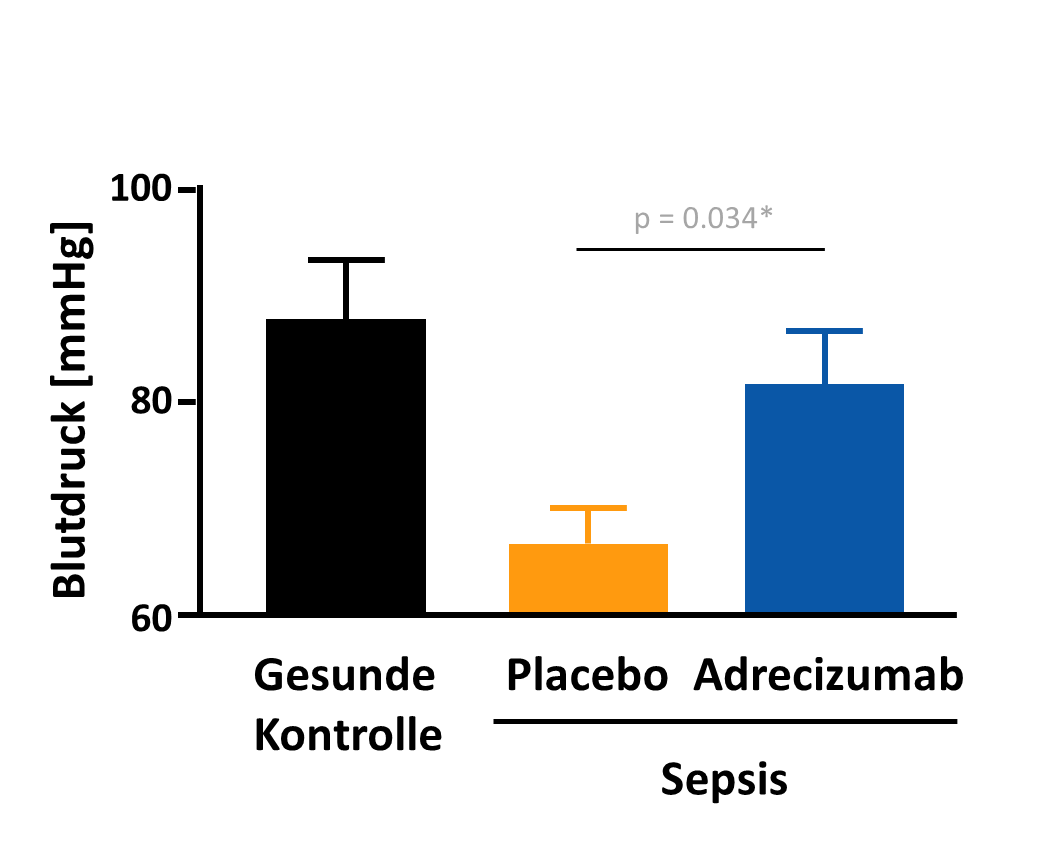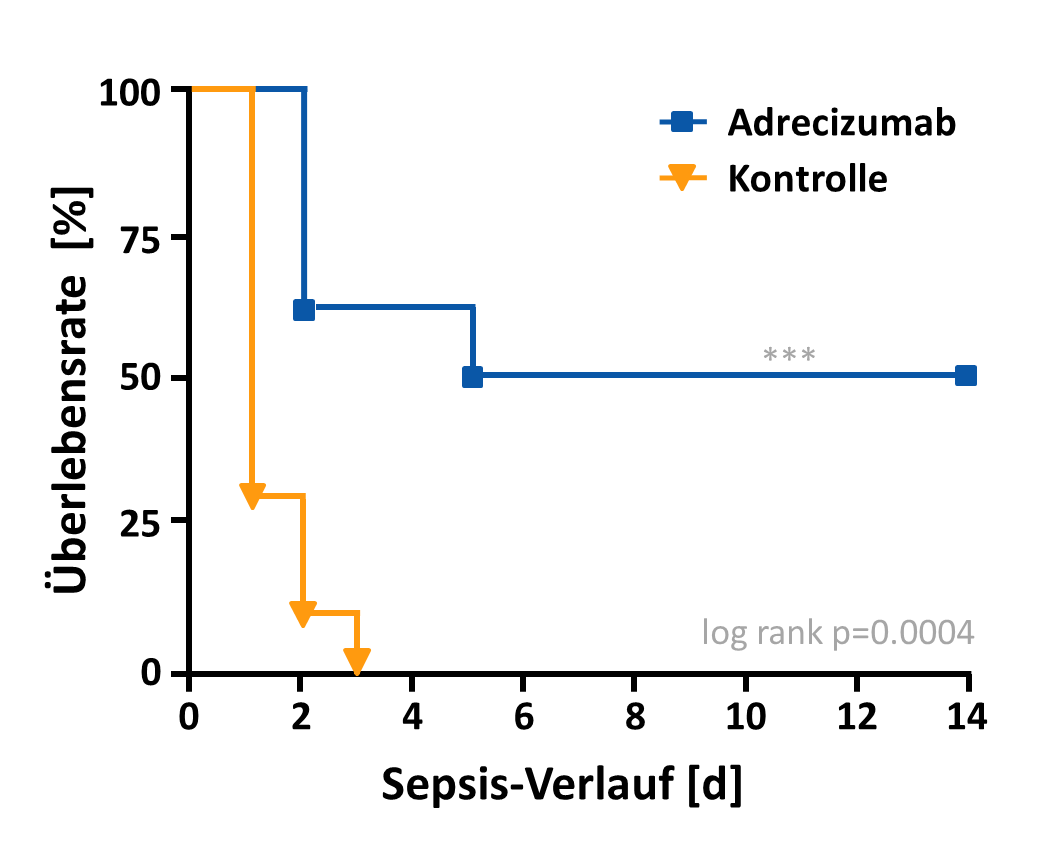Adrenomed ag
Firmenprofil
Die Adrenomed AG ist ein biopharmazeutisches Unternehmen mit einer klaren Mission: Verbesserung der Überlebensrate durch Verbesserung der vaskulären Integrität. Die Adrenomed AG ist ein privat-finanziertes, biopharmazeutisches Unternehmen aus Deutschland mit klinischen Entwicklungsprojekten. Adrenomed verfolgt einen neuen Therapieansatz, um die Integrität und Barrierefunktion der Blutgefäße zu sichern. Diese können bei schweren, bislang unzureichend behandelbaren Erkrankungen durchlässiger werden, so dass es zu lebensbedrohlichen Ödemen und Schock kommen kann. Das Unternehmen wurde 2009 gegründet und wird von einem Management-Team mit jahrzehntelanger Erfahrung in der Indikation Sepsis und profundem Wissen in Diagnostik und Wirkstoffentwicklung geführt. Wichtigster Produktkandidat des Unternehmens ist der monoklonale Antikörper Adrecizumab (INN: Enibarcimab) , der erste Vertreter einer neuen Therapieklasse, der auf das vasoprotektive Peptid Adrenomedullin, einen wesentlichen Regulator der Gefäßintegrität, abzielt. Adrecizumab hat eine Biomarker-gesteuerte, doppelblinde, Placebo-kontrollierte, randomisierte, multizentrische Proof-of-Concept Phase II-Studie mit 301 Patienten in der Indikation septischer Schock erfolgreich beendet. Für weitere Informationen besuchen Sie bitte www.adrenomed.com und folgen Sie Adrenomed direkt auf LinkedIn und Twitter .
AdreCIZUMAB (INN: Enibarcimab)
Antikörper-basierte Therapie zur Verbesserung der Gefäßintegrität
Adrecizumab ist ein humanisierter monoklonaler Antikörper, der das vasoaktive Peptidhormon Adrenomedullin hochspezifisch bindet, ohne seine biologische Aktivität zu blockieren. Adrenomedullin ist ein protektiver Faktor der Blutgefäßintegrität, der dem Austritt von Flüssigkeit aus dem Gefäßen entgegenwirkt.
Die Blutgefäßintegrität ist in einer Vielzahl von medizinischen Zuständen beeinträchtigt. So führt der entzündungsbedingte Verlust der Gefäßintegrität während einer Sepsis häufig zu einem septischen Schock – einem lebensbedrohlichen Blutdruckabfall, der zu einer
verminderten Sauerstoffversorgung der Gewebe und zu Organversagen
führt.
Adrecizumab ist für eine Behandlung von septischen Patienten auf der Intensivstationen bestimmt und der erste Wirkstoffkandidat, der in der Lage ist, das
gesamte Kreislaufsystem während des septischen Schocks zu stabilisieren.
Während der präklinischen Wirkstoffentwicklung wurden die am besten geeigneten Tiermodelle verwendet, die den Verlauf der menschlichen Sepsis und die tatsächlichen Bedingungen auf der Intensivstation möglichst detailgetreu nachahmen. Die Ergebnisse sind sehr vielversprechend: Die Behandlung mit Adrecizumab stellt die Nierenfunktion und die Flüssigkeitsbilanz wieder her, stabilisiert den Blutdruck, reduziert die entzündliche Reaktion und vaskuläre Schädigungen – über den aktuellen Sepsis-Behandlungsstandard hinaus. Die Sterblichkeitsrate sank um 50%.
Adrecizumab besitzt ein ausgezeichnetes Sicherheits- und Verträglichkeitsprofil. Die Infusion von Adrecizumab bei gesunden
Probanden (Phase-I) führt zu einer schnellen Erhöhung des Plasma-ADM-Spiegels.
Eine Klinische Phase-II Studie mit Adrecizumab bei Patienten mit septischen Schock ist erfolgreich abgeschlossen und Sicherheit, Verträglichkeit sowie Wirksamkeit bzgl. Mortalität und Mode of Action bestätigt. Weitere Analysen dieser Studie führten zu zusätzlichen Patenten und Publikationen.
Klinische Ergebnisse



Vorstand
Dr.
Andreas Bergmann
Dr. Jens Zimmermann
Literatur
Wagner et al. Intensive Care Medicine Experimental 2013, 1:2
Adrenomedullin binding improves catecholamine responsiveness and kidney function in resuscitated murine septic shock
Katja Wagner, Ulrich Wachter, Josef A Vogt, Angelika Scheuerle, Oscar McCook, Sandra Weber, Michael Gröger, Bettina Stahl, Michael Georgieff, Peter Möller, Andreas Bergmann, Frauke Hein, Enrico Calzia, Peter Radermacher, Florian Wagner
Intensive Care Med Exp. 2013, 1:2
ABSTRACT
PURPOSE: Adrenomedullin (ADM) has been referred to as a double-edged sword during septic shock: On one hand, ADM supplementation improved organ perfusion and function, attenuated systemic inflammation, and ultimately reduced tissue apoptosis and mortality. On the other hand, ADM overproduction can cause circulatory collapse and organ failure due to impaired vasoconstrictor response and reduced myocardial contractility. Since most of these data originate from un-resuscitated shock models, we tested the hypothesis whether the newly developed anti-ADM antibody HAM1101 may improve catecholamine responsiveness and thus attenuate organ dysfunction during resuscitated murine, cecal ligation and puncture (CLP)-induced septic shock.
METHODS: Immediately after CLP, mice randomly received vehicle (phosphate-buffered saline, n = 11) or HAM1101 (n = 9; 2 μg·g(-1)). Fifteen hours after CLP, animals were anesthetized, mechanically ventilated, instrumented, and resuscitated with hydroxyethylstarch and continuous i.v. norepinephrine to achieve normotensive hemodynamics (mean arterial pressure > 50 to 60 mmHg).
RESULTS: HAM1101 pretreatment reduced the norepinephrine infusion rates required to achieve hemodynamic targets, increased urine flow, improved creatinine clearance, and lowered neutrophil gelatinase-associated lipocalin blood levels, which coincided with reduced expression of the inducible nitric oxide synthase and formation of peroxynitrite (nitrotyrosine immunostaining) in the kidney and aorta, ultimately resulting in attenuated systemic inflammation and tissue apoptosis.
CONCLUSIONS: During resuscitated murine septic shock, early ADM binding with HAM1101 improved catecholamine responsiveness, blunted the shock-related impairment of energy metabolism, reduced nitrosative stress, and attenuated systemic inflammatory response, which was ultimately associated with reduced kidney dysfunction and organ injury.
Struck et al. Intensive Care Medicine Experimental 2013, 1:3
Epitope specificity of anti-Adrenomedullin antibodies determines efficacy of mortality reduction in a cecal ligation and puncture mouse model
Joachim Struck, Frauke Hein, Siegmund Karasch, Andreas Bergmann
Intensive Care Med Exp. 2013, 1:3
ABSTRACT
INTRODUCTION: Adrenomedullin (ADM), a circulating vasodilatory peptide, plays an
important role in the development of sepsis-associated hemodynamic and
microcirculatory disorders. While administration of exogenous ADM had beneficial
effects in several septic animal models, elevated ADM concentrations are
associated with a bad outcome. This prompted us to test the effect of various
anti-ADM antibodies in a cecal ligation and puncture (CLP) mouse model.
METHODS: To gain new potential compounds for the treatment or prevention of
septic shock we followed an alternative strategy to influence the ADM system:
High-affinity anti-ADM antibodies with different epitope specificities were
developed and their antagonist activity in vitro and their ability to reduce
mortality in a CLP mouse model were assessed.
RESULTS: An anti-ADM antibody directed against the N-terminus substantially increased the survival of mice in a CLP model (HR = 0.077 (CI = 0.0189 to 0.315), p = 0.0004), whereas other antibodies with similar affinities but different epitope specificities were much less potent. The efficacious antibody, in contrast to an anti-C-terminal antibody, only partially inhibited ADM agonist activity in vitro. Healthy mice were not negatively affected by the N-terminal antibody. CONCLUSIONS: An anti-N-terminal ADM antibody, as opposed to antibodies with other epitope specificities, strongly reduces mortality in CLP mice.
Marino et al. Critical Care 2014, 18(1):R34
Plasma adrenomedullin is associated with short-term mortality and vasopressor requirement in patients admitted with sepsis
ABSTRACT
INTRODUCTION: The incidence of death among patients admitted for severe sepsis or septic shock is high. Adrenomedullin (ADM) plays a central role in initiating the hyperdynamic response during the early stages of sepsis. Pilot studies indicate an association of plasma ADM with the severity of the disease. In the present study we utilized a novel sandwich immunoassay of bioactive plasma ADM in patients hospitalized with sepsis in order to assess the clinical utility.
METHODS: We enrolled 101 consecutive patients admitted to the emergency department with suspected sepsis in this study. Sepsis was defined by fulfillment of at least two systemic inflammatory response syndrome (SIRS) criteria plus clinical suspicion of infection. Plasma samples for ADM measurement were obtained on admission and for the next four days. The 28-day mortality rate was recorded.
RESULTS: ADM at admission was associated with severity of disease (correlation with Acute Physiology and Chronic Health Evaluation II (APACHE II) score: r = 0.46; P <0.0001). ADM was also associated with 28-day mortality (ADM median (IQR): survivors: 50 (31 to 77) pg/mL; non-survivors: 84 (48 to 232) pg/mL; P <0.001) and was independent from and additive to APACHE II (P = 0.02). Cox regression analysis revealed an additive value of serial measurement of ADM over baseline assessment for prediction of 28-day mortality (P < 0.01). ADM was negatively correlated with mean arterial pressure (r = -0.39; P <0.0001), and it strongly discriminated those patients requiring vasopressor therapy from the others (ADM median (IQR): no vasopressors 48 (32 to 75) pg/mL; with vasopressors 129 (83 to 264) pg/mL, P <0.0001).
CONCLUSIONS: In patients admitted with sepsis, severe sepsis or septic shock plasma ADM is strongly associated with severity of disease, vasopressor requirement and 28-day mortality.
Beteiligungsgrundsätze
Mehr erfahren ...
AngioBiomed GmbH
AB2302 | Antikörper-basierte Tumortherapie
